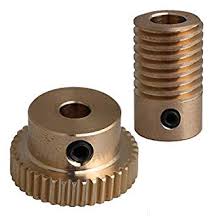The steel can be used for high strength worm gears (worm wheel) and steel could be plain carbon steel or alloy steel. The metal gears are generally heat treated in order to combine properly the toughness and tooth hardness.
The phosphor bronze is widely used for worms drive as a way to reduce wear of the worms which is excessive with cast iron or steel.
Worm gear models are usually used to reduce speed and enhance torque. Since the worm drive undergoes more contact tension cycles compared to the worm gear, the worm drive is generally of a better material.
• Cast iron provides toughness and ease of manufacture.
• Cast steel provides a lot easier fabrication, strong operating loads and vibration resistance.
• Carbon steels are economical and solid, but are susceptible to corrosion.
• Aluminum is employed when low equipment inertia with some resiliency is required.
• Brass is inexpensive, simple to mold and corrosion resilient.
• Copper is easily formed, conductive and corrosion tolerant. The gear’s power would increase if bronzed.
• Plastic is economical, corrosion resistant, quiet operationally and can overcome missing the teeth or misalignment. Plastic is significantly less robust than metal and is vulnerable to temperature improvements and chemical substance corrosion. Acetal, delrin, nylon, and polycarbonate plastics are normal.
This 27 tooth brass worm gear is intended to be used in combination with a worm gear to make a 27:1 decrease in speed while also changing the orientation of the rotating axis by 90 degrees. This equipment fastens to a 1/4″ shaft using a specialised 1/4″ D-hub to be used with 1/4″ D-shaft.
The manufacturing methods of worms are roughly divided among cutting, heat treated and ground after cutting and rolling. And for worm wheels, they can be approximately divided among cutting the teeth, cutting teeth after casting, and tooth cutting after the exterior rim  is normally cast around the guts of the blank.
is normally cast around the guts of the blank.
